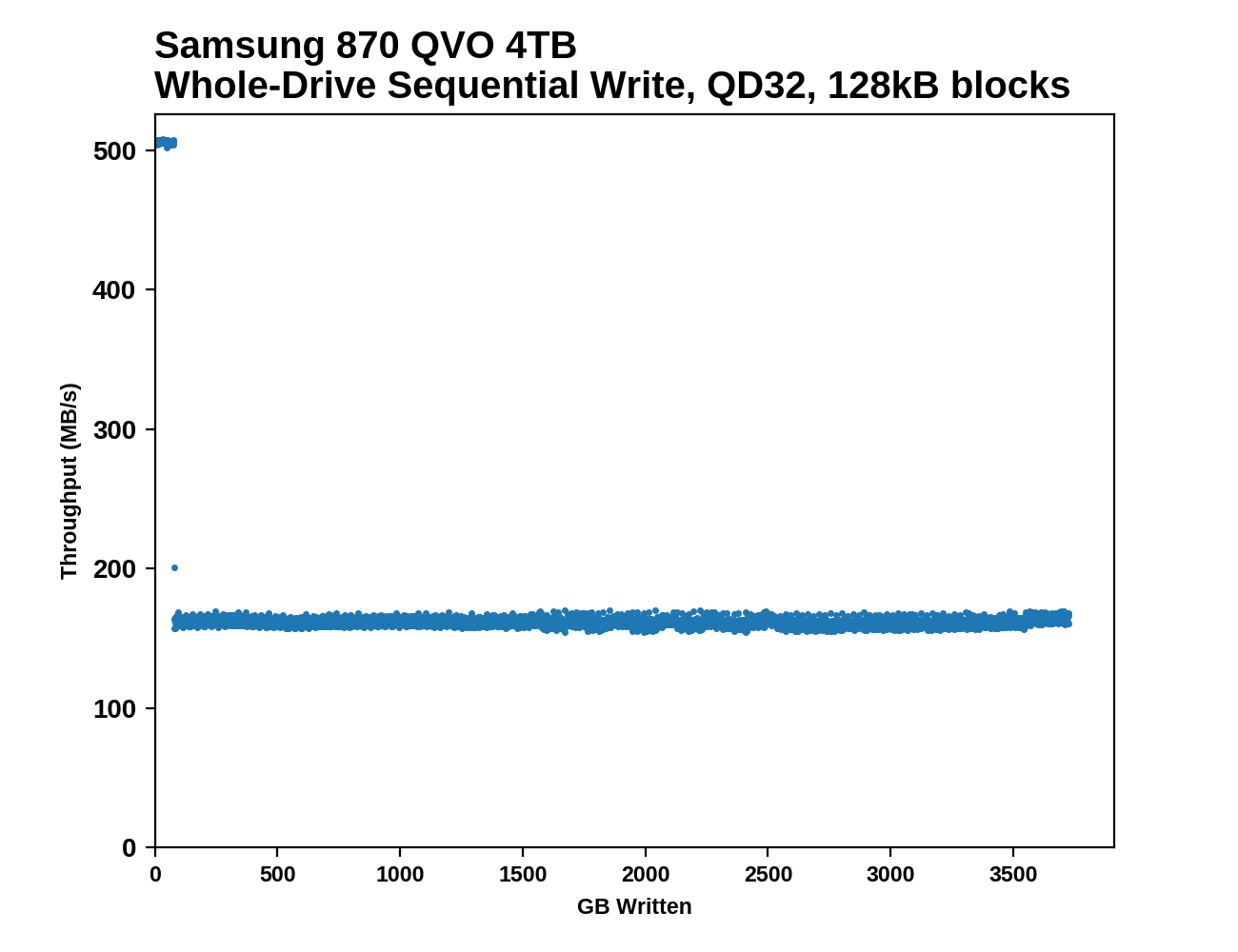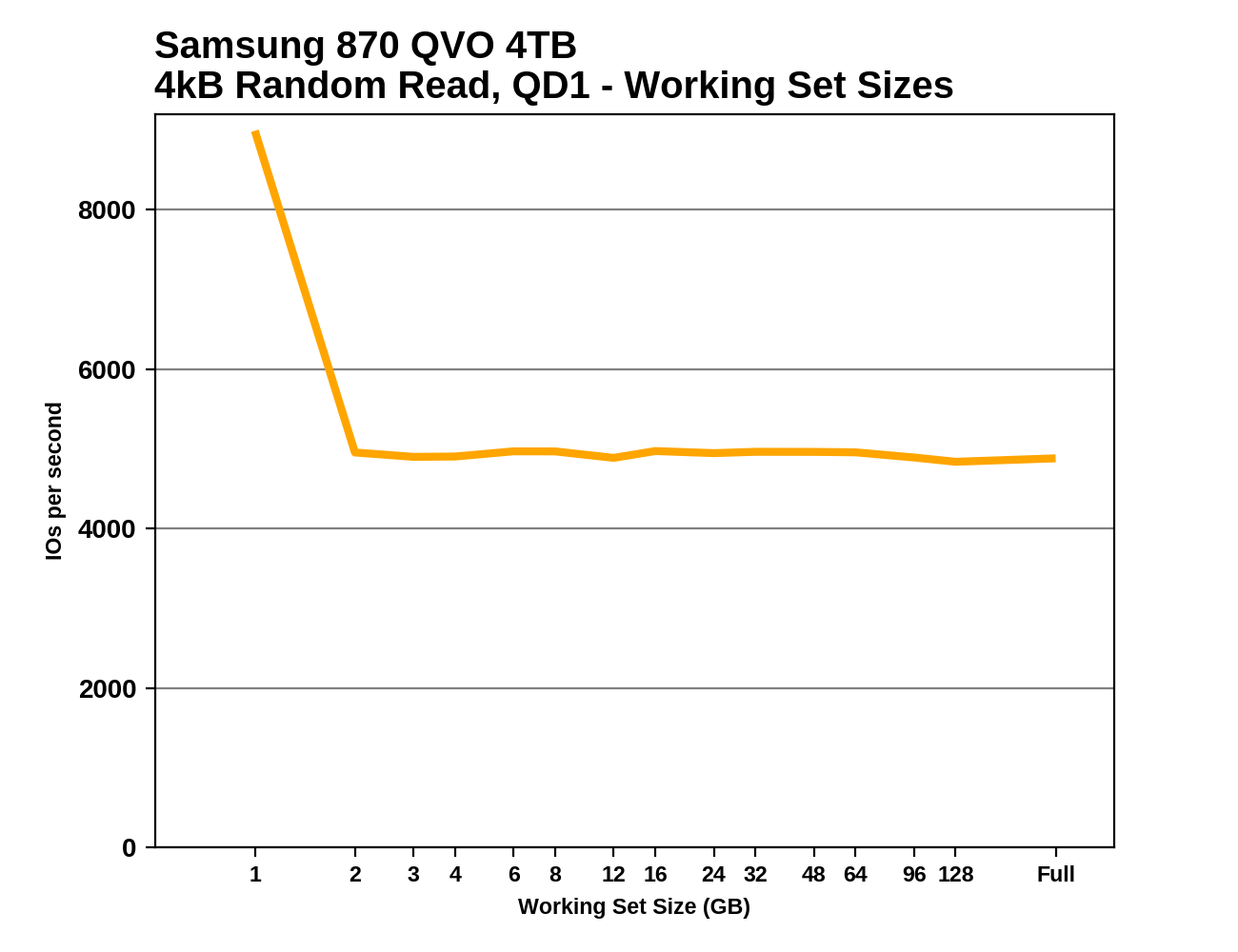The Samsung 870 QVO (1TB & 4TB) SSD Review: QLC Refreshed
by Billy Tallis on June 30, 2020 11:40 AM ESTWhole-Drive Fill
This test starts with a freshly-erased drive and fills it with 128kB sequential writes at queue depth 32, recording the write speed for each 1GB segment. This test is not representative of any ordinary client/consumer usage pattern, but it does allow us to observe transitions in the drive's behavior as it fills up. This can allow us to estimate the size of any SLC write cache, and get a sense for how much performance remains on the rare occasions where real-world usage keeps writing data after filling the cache.
 |
|||||||||
The SLC caches on the 870 QVOs run out right on schedule, at 42 GB and 78 GB. Write performance drops precipitously but is stable thereafter, for the rest of the drive fill process. This behavior hasn't changed meaningfully from the 860 QVO.
 |
|||||||||
| Average Throughput for last 16 GB | Overall Average Throughput | ||||||||
The 870 QVO turns in scores that are very similar to its predecessor. The 1TB model averages similar write performance to a hard drive, albeit with very different performance characteristics along the way. The 4TB model manages to stay ahead of the hard drive's write performance for pretty much the entire run. Both capacities of QLC drives offer a mere fraction of the post-cache write speed of mainstream TLC drives, and even the 2TB DRAMless TLC drive offers much better sequential write performance for almost all of the test duration.
Working Set Size
Most mainstream SSDs have enough DRAM to store the entire mapping table that translates logical block addresses into physical flash memory addresses. DRAMless drives only have small buffers to cache a portion of this mapping information. Some NVMe SSDs support the Host Memory Buffer feature and can borrow a piece of the host system's DRAM for this cache rather needing lots of on-controller memory.
When accessing a logical block whose mapping is not cached, the drive needs to read the mapping from the full table stored on the flash memory before it can read the user data stored at that logical block. This adds extra latency to read operations and in the worst case may double random read latency.
We can see the effects of the size of any mapping buffer by performing random reads from different sized portions of the drive. When performing random reads from a small slice of the drive, we expect the mappings to all fit in the cache, and when performing random reads from the entire drive, we expect mostly cache misses.
When performing this test on mainstream drives with a full-sized DRAM cache, we expect performance to be generally constant regardless of the working set size, or for performance to drop only slightly as the working set size increases.
 |
|||||||||
The 870 QVO clearly has improved read latency over its predecessors, and that's enough for the 1TB 870 to slightly outperform the ADATA SU750, a DRAMless TLC drive. The 4TB 870 QVO also shows a new behavior, with excellent random read performance at the very beginning of the test—better even that the TLC-based 860 EVOs. It looks like this test may have caught some data that was still being served from the SLC cache. Otherwise, the 870 QVOs don't care much about data locality for random reads, unlike many drives with limited or no DRAM cache.










64 Comments
View All Comments
Oxford Guy - Tuesday, June 30, 2020 - link
QLC is a bad product at a bad price.scineram - Friday, July 3, 2020 - link
Narrator: "There are bad products"Operandi - Tuesday, June 30, 2020 - link
I think Samsung is just cashing in a bit on their name and reputation they built up over the years when even the a lot of the bigger names in memory and storage had drives with questionable reliability and performance.Having said that the 4TB and 8TB drives are fine since nobody else can really play in that space. Maybe Samsung shoudn't even bother with sub 4TB for the QVO series. It would certainly look better from a market perspective.
Oxford Guy - Tuesday, June 30, 2020 - link
Samsung's reliability hasn't been so legendary. There was the regular 840 drive that was so bad in the 128 GB capacity that even without steady state it was like laptop hard drive slow. Then there was the 840 EVO that needed a kludge work-around to "solve" the problem of random data loss.Daro - Tuesday, June 30, 2020 - link
All my SSDs that died were Samsung: 3 840 evos, and 2 850 evos. I ll ve never buy another samsung SSD in my life.leexgx - Wednesday, July 1, 2020 - link
It's really random luck on failure of an SSD (only had 1 samsung evo witch I might of destroyedsystem was ignored for over 30 days powered up, when I got to it the system was up at desktop,but nothing would open so hard to force power cycle it had smart fail no boot, I think something was writing constantly to the ssd or power issue,, other 3 ssds was cheap SanDisk plus (I think) after 6-12 months they started missing data on reads
voicequal - Thursday, July 2, 2020 - link
I've never personally lost data on a Samsung SSD, which can't be said for others. 840 EVOs were a stretch, pushing TLC planar NAND to its limits, but 850 EVOs cleared that up with V-NAND. Now we're back to QLC pushing the limits again.khanikun - Monday, July 6, 2020 - link
Reason I stopped buying Samsung. Everything I've bought from them has broken in some way. Not broken enough that they don't work, but broken enough that they were annoying. Monitors, the power button would semi-function. I'd be slapping the button with my finger to get it to turn on/off. Be doing that like 10 times until it'd eventually go.Only had one SSD from Samsung. Got it for free with my monitor. Some Newegg deal. It started getting bad sectors in a year. Samsung TV, the remote stopped working. Samsung bluray player, simply broke. I just avoid them now.
eek2121 - Tuesday, June 30, 2020 - link
The prices are...underwhelming to say the least. While this may be cheaper than other Samsung drives, Samsung does not exist in a void. There are other TLC and even MLC drives that can be had cheaper. Anything above $100/tb is too much IMO, unless there is a compelling reason (such as performance) to justify the premium.eek2121 - Tuesday, June 30, 2020 - link
The Crucial MX500, BX500, Sandisk SSD Plus, and many other SSDs are available on Amazon right now for $199.99 for a 2TB offering.